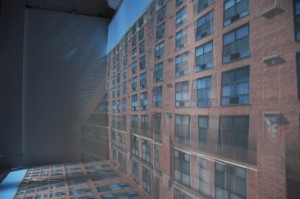
"Orbis Obscurus" (Detail) Ethan Jackson 2008
Ethan Jackson's transformation of the New American Art Union this month is beautiful and baffling. Walking into the first section of the exhibit, Jackson has transformed the front windows of the gallery space into a giant camera obscura entitled 'Polyopticon VII' which depicts the side of the street opposite the gallery. Despite the advanced nature of the technology of optics in this day and time, this ancient discovery of the nature of lenses never fails to awe an audience. As humans, we love seeing the world projected and duplicated, especially larger than life and in real time. Sitting in the first section of the exhibition has a calming effect on the viewer; it is a silent upside down movie without a plot, the mirror image of what exists inside the brain if we turned around and watched the scene behind us. In this way, this section is a strange bouncing off of identical images we perceive and which our brains automatically interpret. The camera obscura is also the secret of Old Master painting techniques, and in this way the exhibition's luminosity and beauty bask in a sort of nostalgic, painterly glow. This is the introduction to Jackson's ideas and to the inflections of his style.

Diagram of Camera Obscura
We leave the first section of the exhibition, guided by a diagram provided by the gallery. In the center of NAAU's space, four television monitors ('Orbis Obscurus') are arranged in a circle. Their screens face the ceiling, and atop each sits a mirrored cylinder. Each monitor depicts swirling whorls of changing colors and as the viewer looks into each cylinder, a traveling view of a three dimensional landscape appears, as if one is flying over the surface of the earth, so to speak.

'Orbis Obscurus' Ethan Jackson 2008
These pieces are visually neat; they display a sort of virtual, inside out kaleidoscope, and it is with these pieces that Jackson most directly points to what he claims to be talking about with this exhibit: a dark and unrecognized mental space that hovers between the meeting point of perception and vision. This is the abstract space Jackson believes to house a sort of transcendental imagination. The entirely abstract nature of this concept is not difficult to comprehend, yet it is not entirely conveyed when looking at the work. The strongest point of the exhibiti is the sheer beauty of Jackson's reification. These pieces are mesmerizing. They are lyrical and poetic.

'Polyopticon IV' Ethan Jackson, Artspace, New Haven CT 2007
Jackson's statement accompanying the diagram delves haphazardly into the inspiration of literature concerning the choices of which landscape fragments he employs for 'Orbis Obscurus'. Yet this information is arbitrary and only serves to weaken the experience of his work. It is apparent that the formal elements of the pieces, when analyzed, would perhaps point to these concepts, yet to mentally travel to this sort of space seems forced. When arriving at these concepts, one naturally jumps to the question of why and is abruptly stopped. Does Jackson propose that this is where the imagination dwells? Where the darkness of the human spirit lurks? Is this place what he deems the 'Orbis Viridis Obscurus'? I am not sure. It seems that by laying these concepts across the tops of these ethereal works might actually be somewhat damaging to them. To allow this work to exist in its own right allows it to breathe and move in the viewer's eye and mind, allows it to move beyond perhaps what the artist ever intended.
In many ways, this exhibition feels as if it calls to the musings of the renaissance spirit in a contemporary context. As many technically advanced optics as this exhibition employs, it waxes nostalgic for the days of old film. The projections of the camera obscura feel like the projections of old film reels. Artists like Joseph Cornell, James Turrell,

'Sky Space' Devin Borden Hiram Butler Gallery, James Turrell 2001
and Shimon Attie

'Mulackstrasse 37 Berlin, 1993', slide projection of Jewish residents (ca. 1932) Shimon Attie 1993
come to mind, artists all interested in the essence of the passage of time and how the landscape (whether natural or constructed) acts as stage and symbol. Jackson's work also uses the lens as poetic purveyor, turning the landscape upside down and inside out to make us pay attention to our surroundings and the actuality of our perception.
Thanks for signing in,
. Now you can comment. (sign
out)
(If you haven't left a comment here before, you may need to be approved by
the site owner before your comment will appear. Until then, it won't appear
on the entry. Thanks for waiting.)

























